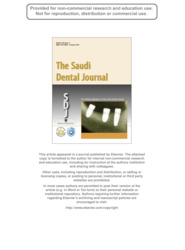Ethnic differences in dentofacial relationships of Turkish and Saudi young adults with normal occlusions and well-balanced faces
-
Eser Sahibi
TANCAN UYSAL
-
Tür
Makale
- Yayın Tarihi 2011
-
Yayıncı
The Saudi Dental Journal
- Dergi Adı The Saudi Dental Journal 23, ( 4 ), pp.183 - 190
- Tek Biçim Adres Http://hdl.handle.net/11469/178
-
Konu Başlıkları
Cephalometric norm
Turkish
Saudi
Ethnicity
Objectives: The aims of the present study were (1) to determine ethnic differences in craniofacial
dimensions between Turkish and Saudi populations and (2) to identify possible gender differences
between males and females, based on a sample of untreated young adult subjects with
normal occlusions and well-balanced faces.
Methods: In total, 163 cephalometric radiographs were traced and evaluated to compare
untreated adults of Turkish and Saudi ethnicity. The Turkish group comprised 86 subjects; 45
females and 41 males. The Saudi group comprised 77 subjects; 39 females and 38 males. For statistical
evaluation, an independent-samples t-test was performed.
Results: The Turkish sample had a more retrognathic maxilla and mandible (p< 0.001 for SNA
and SNB) and a more vertical direction of facial development (p< 0.001), with Turkish males having
more retrusive lips (p< 0.001). Distinctive ethnic differences were found in craniofacial structures
between Turkish and Saudi young adults.
Conclusions: It is appropriate to consider these aesthetic differences when a Turkish or a Saudi
patient is being evaluated during routine diagnosis and treatment planning.

 Tam Metin
Tam Metin

